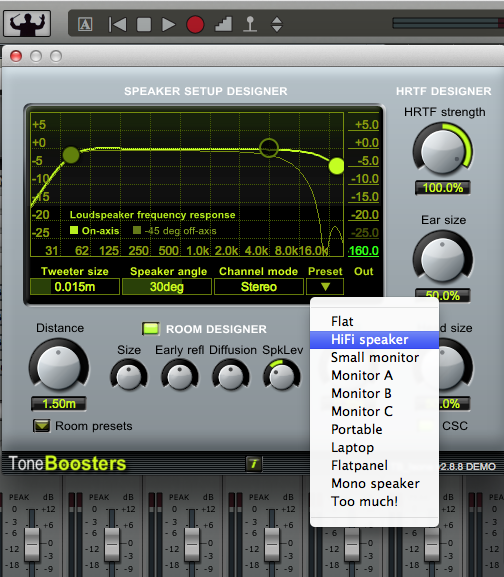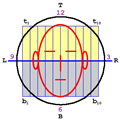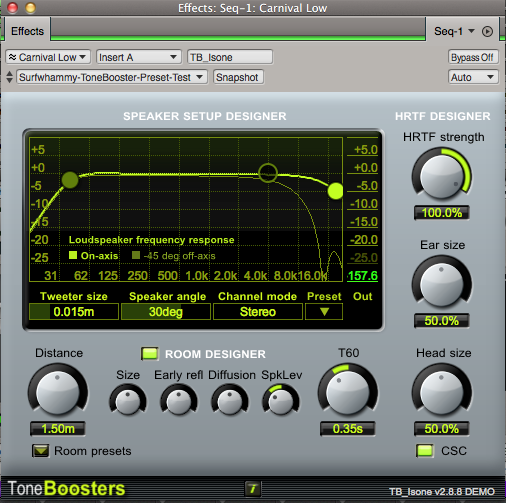I'm using Toneboosters VST plug-ins. Could it be the difference between VST and AU plug-in instances?
- It is currently Fri Dec 19, 2025 1:35 pm • All times are UTC - 5 hours [ DST ]
Attention:
Welcome to the old forum. While it is no longer updated, there is a wealth of information here that you may search and learn from.
To partake in the current forum discussion, please visit https://forums.presonus.com
Plug-Ins
5 posts
• Page 1 of 1
Plug-Ins
Anybody have any idea why my plug-ins don't show their presets in Notion 4? When I use them in Logic or Reaper the presets are visible. In Notion there is no option for selecting or saving presets.
I'm using Toneboosters VST plug-ins. Could it be the difference between VST and AU plug-in instances?

I'm using Toneboosters VST plug-ins. Could it be the difference between VST and AU plug-in instances?
Michael
Notion 4 Mac
VSL Dimension Strings
VSL Special Edition 1,2, Plus
Miroslav Philharmonik
Apple Logic
Notion 4 Mac
VSL Dimension Strings
VSL Special Edition 1,2, Plus
Miroslav Philharmonik
Apple Logic
-

idiotSavant - Posts: 302
- Joined: Tue Dec 18, 2012 8:20 pm
- Location: San Francisco, CA
Re: Plug-Ins
idiotSavant wrote:Anybody have any idea why my plug-ins don't show their presets in Notion 4? When I use them in Logic or Reaper the presets are visible. In Notion there is no option for selecting or saving presets.
I'm using Toneboosters VST plug-ins. Could it be the difference between VST and AU plug-in instances?
The free versions of the ToneBooster plug-ins do not allow parameter saving, but I was able to load the list of presets for the free versions that have presets, where one example is shown in the following screen capture of the Isone VST plug-in running in NOTION 4 (64-bit) . . .

A few of the other ToneBooster plug-ins (free versions) do not appear to have parameters that can be saved as presets, but this might be due to being free versions . . .
The correct location on the Mac for the AU and VST plug-ins is in the "Plug-ins" subfolder of the "Audio" subfolder of the "Library" folder, where there are separate subfolders for "VST", and "VST3" plug-ins. The Audio Unit (AU) components are kept in the subfolder named "Components", and there are other folders for different plug-in formats, as well . . .
There are different versions of the VST and VST3 infrastructure, so another possibility is that NOTION 4 is using an older VST infrastructure but the ToneBooster's plug-ins are using a newer VST infrastructure with procedures that are not supported in older or previous versions of the VST infrastructure . . .
[NOTE: Regarding the possibility that there are VST technology mismatches, I did a bit more checking and NOTION 4 supports Steinberg's VST 2.4 technology, but at present does not support VST 3.x, which on the Mac you can verify by clicking on the "Acknowledgments" button at the lower-right of the "About . . ." dialog, hence as explained subsequently NOTION 4 and the ToneBooster effects plug-ins are using the same version of Steinberg's VST technologies, so it was an interesting hypothesis but is not applicable in this instance . . . ]
I know that some of the FabFIlter Software Instruments VST plug-ins do not automatically save parameters when you exit NOTION 4, but whether this is a bug in the FabFilter Software Instruments plug-ins or NOTION 4 is not so easy for me to determine, although since IK Multimedia VST plug-ins allow parameter saving automatically, as well as user-defined preset creating, loading, and modifying, I tend to view this as a bug or discrepancy with the plug-in rather than as a bug in NOTION 4 . . .
The ToneBooster's website indicates that their VST plug-ins are using the VST 2.4 infrastructure . . .
This is the information I was able to find and verify at present . . .
Lots of FUN!
P. S. From a different perspective, this exercise is a nice example of what I call "scouting around" as a technique for discovering how stuff works, which is a technique I learned from a senior programmer when I first started working on computers, and he called it "scouting around", where the general idea is that you make hypotheses; ask questions; look everywhere; do experiments; and so forth and so on toward the goal of being able to make logical inferences. This was when I was working on the NASA Shuttle Mission Simulator (SMS), and whenever it stopped working and nobody could discover why, they called this fellow and after a while he solved the problem, so since he was my supervisor I asked him how it did it, and he let me watch a few times and explained how "scouting around" works, where the amusing aspect was that he also told me that he had no advance clues about how anything worked, hence it really was a matter of looking at everything in a focused way toward the goal of finding something that did not look right, at which point you make it look right and see what happens, which in the grand scheme of everything is a variation of the rule that "If it's not broken, then don't fix it", with the idea in this instance being that if it is broken, then you need to fix it, so you start by finding the part that is broken, where the key aspect is that you need to know how to see everything, where the "doing experiments" aspect is a technique for "seeing" stuff that you cannot see directly, really . . .
Really!
Last edited by Surfwhammy on Sat Jul 13, 2013 1:54 am, edited 5 times in total.
-

Surfwhammy - Posts: 1137
- Joined: Thu Oct 14, 2010 4:45 am
Re: Plug-Ins
Thanks SW, I will check ToneBoosters to see if there are different versions required for the demo vs registered plug-ins. That might explain it. However, I doubt it since when I use the same plug-ins with Logic I see the presets just fine, and can save parameter settings to user presets without a problem.
This tells me that your theory about Notion implementation of VST may be closer to the mark.
Admin, can you help out here?
This tells me that your theory about Notion implementation of VST may be closer to the mark.
Admin, can you help out here?
Michael
Notion 4 Mac
VSL Dimension Strings
VSL Special Edition 1,2, Plus
Miroslav Philharmonik
Apple Logic
Notion 4 Mac
VSL Dimension Strings
VSL Special Edition 1,2, Plus
Miroslav Philharmonik
Apple Logic
-

idiotSavant - Posts: 302
- Joined: Tue Dec 18, 2012 8:20 pm
- Location: San Francisco, CA
Re: Plug-Ins
Man it's an off night. My head isn't working well. The presets show up in Apple Logic because they're being loaded as AU plug-ins. So that really doesn't prove anything...
Michael
Notion 4 Mac
VSL Dimension Strings
VSL Special Edition 1,2, Plus
Miroslav Philharmonik
Apple Logic
Notion 4 Mac
VSL Dimension Strings
VSL Special Edition 1,2, Plus
Miroslav Philharmonik
Apple Logic
-

idiotSavant - Posts: 302
- Joined: Tue Dec 18, 2012 8:20 pm
- Location: San Francisco, CA
Re: Plug-Ins
idiotSavant wrote:Man it's an off night. My head isn't working well. The presets show up in Apple Logic because they're being loaded as AU plug-ins. So that really doesn't prove anything...
Digital Performer 8 (MOTU) supports both AU and VST plug-ins, where support for VST plug-ins on the Mac is a new feature for Digital Performer 8, so I am doing some experiments with Digital Performer 8, although so far I have not discovered how to get it to load VST plug-ins . . .
[NOTE: The information about Digital Performer 8 supporting the VST format for plug-ins is found at the bottom of the following link, so it should work, but since this is a new feature I need to discover how it works. And for reference, previous versions of Digital Performer only supports Audio Unit (AU) plug-ins, as well as running only on the Mac, but beginning with Digital Performer 8, it runs on Windows and on the Mac, as well as supporting Steinberg's VST technology, but the AU support is only for the Mac, since it is an Apple technology. Hence if you are running Digital Performer 8 on the Mac, you get both AU and VST, but if you are running the Windows version of Digital Performer 8, then you get VST . . . ]
Digital Performer 8 (MOTU)
Nevertheless, I would expect differences in the way AU and VST plug-ins are implemented, hence the reason for trying it in Digital Performer 8, where if I can get it to load VST plug-ins, then I can compare the AU implementation with the VST implementation . . .
Lots of FUN!
P. S. After discovering how to load VST plug-ins to Digital Performer 8, I did some experiments and was able to create and to recall user-defined presets for the ToneBooster's "Isone" plug-in, both for the AU and VST versions, but the key bit of information is that in Digital Performer 8 this is done in a way where Digital Performer 8 handles the user-defined preset defining, loading, modifying, and saving rather than the ToneBooster plug-ins . . .
[NOTE: Digital Performer 8 automatically recognizes and scans AU effects plug-ins, but for VST effects plug-ins you need to tell Digital Performer 8 to look at the specific VST plug-in, which is easy to do but does not happen automatically . . . ]
In other words, at least for the free versions of the ToneBooster's VST plug-ins, working with user-defined presets is accomplished by having the Digital Audio Workstation (DAW) application itself create the user-defined presets, which explains why NOTION 4 does not support creating, modifying, and saving user-defined presets for some plug-ins . . .
Explained another way, it appears (a) that the ToneBooster VST plug-ins expose their parameters, where "expose" is a programming term that refers to making something visible in a way that allows working with it via code and (b) that a DAW application can save exposed parameters as an externally defined user-defined preset, but with NOTION 4 there is no support for creating user-defined presets externally to the various VST plug-ins, and since the free versions of the ToneBooster VST plug-ins do not provide a graphic user interface (GUI) control for working with user-defined presets, the ToneBooster VST plug-ins running in NOTION 4 do not have any of these presets . . .
As an example, for the ToneBooster "Isone" effect plug-in, there are two supported presets, as shown in the screen capture in my previous post, where one set of presets is for "Room Presets" and the other set of presets is for different types of monitoring systems and is the one at the bottom of the graph in the middle of the plug-in's graphic user interface . . .
It is possible that this second set of presets will support user-defined preset in the full version of the ToneBooster effects plug-ins, and if it does, then there will be a "Save", "Save As . . . ", or some type of additional item(s) in the drop-down listbox to indicate that you want to create, load, modify, or save a user-defined preset, but the only way I can verify this hypothesis is to purchase the full-version, which at present is not practical for me to do, since I am saving money to get the full version of Cyclop (Sugar Byes) . . .
[NOTE: Cyclop looks to be the definitive bass synthesizer VSTi virtual instrument plug-in for Electronic genres, including Dubstep, which is the reason I want it . . . ]
Cyclop (Sugar Bytes)
Reiterating, Digital Performer 8 will take a "snapshot" of all the exposed parameters for an AU or VST plug-in, which Digital Performer 8 uses to create, load, modify, and save a custom "snapshot", which it calls a "preset", which is fine with me, but this is different from the VST effect plug-in doing this itself and handling everything within the plug-in framework, and it is this latter functionality that NOTION 4 does not support . . .
[NOTE: The "Snaphost" button does something different, where it records information for automation purposes, but conceptually a user-defined preset is a type of snapshot in the general usage of the word. In this example, the Digital Performer 8 user-defined preset is shown in the area above the actual graphic user interface for the VST plug-in, which is a clue that it is functionality provided by the higher-level DAW application provided container. In other words, compare this screenshot to the similar but different screenshot of the plug-in as it appears in NOTION 4 (see my previous post to this topic), and you can see the additional information and functionality that Digital Performer 8 provides . . . ]

If the VST plug-in supports user-defined presets, then everything is fine, so long as the VST plug-in is able to recall its user-defined presets and to provide information to NOTION 4 so that NOTION 4 can include the information in the NOTION 4 score or project file so that when the NOTION 4 score or project is opened at some later time NOTION 4 knows what to tell the plug-in to do with respect to parameter settings, but otherwise NOTION 4 does not support the types of "snapshots" that Digital Performer 8 does, which is fine with me because doing "snapshots" of exposed plug-in parameters occurs at a higher level than the plug-in, itself, and is what I consider to be an advanced DAW application functionality, where based on this hypothesis the DAW application has the ability to save everything separately from whatever the plug-in might do within the AU and VST frameworks, with the general idea in terms of standard plug-in designing and coding practices being that it is better for the AU and VST plug-ins to save user-defined presets within their respective frameworks rather than to expect the DAW application or host application to provide this functionality externally . . .
And for reference, I base this hypothesis on the facts (a) that the 64-bit IK Multimedia AU and VST plug-ins fully support user-defined presets and (b) NOTION 4 works as I expect it to work with the IK Multimedia plug-ins, which from my perspective is strong evidence that IK Multimedia and Notion Music are following the generally accepted rules for the AU and VST plug-in technologies, infrastructures, and frameworks. Digital Performer 8 (MOTU) goes a step beyond this and provides a way to work with "snapshots" regardless of the way individual plug-ins support or do not support user-defined presets, but this additional functionality is an advanced DAW application type of thing, really . . .
Really!
-

Surfwhammy - Posts: 1137
- Joined: Thu Oct 14, 2010 4:45 am
5 posts
• Page 1 of 1
Who is online
Users browsing this forum: No registered users and 80 guests